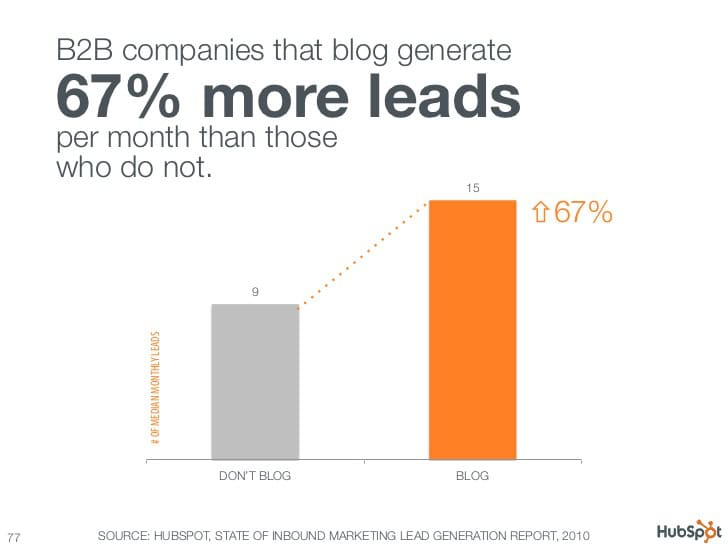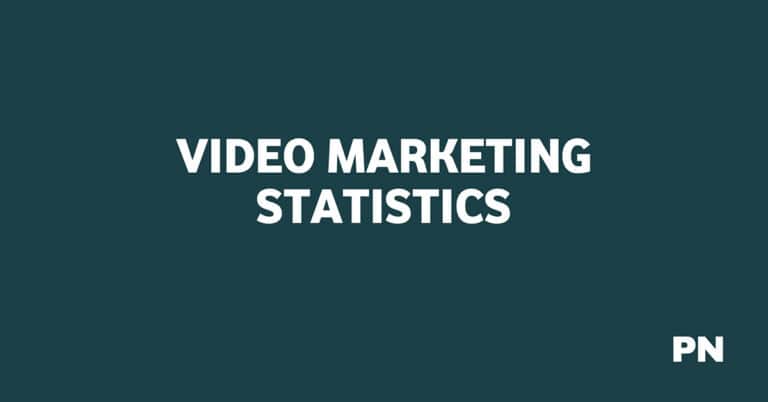69 Stunning Blogging Statistics 2024

You’re reading this article, so chances are you’re interested in blogging statistics. And why wouldn’t you be?
Blogging has become ubiquitous on the internet, with millions of active blogs covering every topic.
Do you know that over 600 million active blogs, or 77% of Internet users, still read blogs?
With over 3 billion blog posts published each year worldwide, blogging is still a popular and thriving form of content creation.
But who’s reading them? What are the most popular types of content, and how do bloggers make money? I’ll explore 69 blogging statistics in this article that answer these questions.
1. There are over 600 million active blogs across the internet.
(Source: OptinMonster)
Blogging has become a popular way for people to express their thoughts and ideas online.
This number is expected to continue growing as more people turn to blogging to share their experiences and connect with others.
The rise of social media platforms has also contributed to the growth of blogging. Many bloggers use social media to promote their blogs and reach a wider audience.
2. 77% of internet users still read blogs.
(Source: Ahrefs)
Blogging has been around for over two decades, and despite the rise of social media platforms, it remains a popular medium for sharing information and opinions.
One reason blogs are enduringly popular is their versatility. Bloggers can cover various topics, from personal experiences to industry news and analysis.
Additionally, blogs can be easily accessed and consumed on various devices, including smartphones and tablets. Furthermore, blogs offer a more in-depth and nuanced perspective on topics than social media platforms.
3. 3 billion blog posts are published each year worldwide.
(Source: IsItWP)
As blogging continues to gain popularity, the number of blog posts published each year is rising. This staggering number highlights the importance of creating high-quality content that stands out.
4. Over 31 million active bloggers post at least once per month in the United States.
(Source: The Tech Report)
This number is expected to grow as more people blog to express themselves and connect with others.
5. More than 50% of bloggers are between 21 to 35 years old.
(Source: Hubspot)
As a blogger within this age range, you have a unique advantage. You understand the latest technology and social media trends, which can help you create content that resonates with your audience.
Additionally, you have the energy and drive to create new and engaging content consistently.
6. Blog posts remain the most popular content format, with 9 out of 10 marketers using blogging to achieve content goals.
(Source: HubSpot)
When it comes to content marketing, blogging is still the king. Blog posts effectively engage with your audience, build brand awareness, and establish yourself as an industry expert.
In addition, blog posts are easy to create and share. They can also be formatted in various ways, including lists, how-to guides, and opinion pieces, making them a versatile content format.
Blogging also allows for search engine optimization (SEO) benefits, as search engines love fresh, relevant content.
7. 80% of bloggers are driving strong marketing results.
(Source: Orbit Media)
If you’re not blogging for your business, you’re missing out on a huge opportunity to connect with your audience and drive sales.
One reason for this high success rate is that blogging allows you to establish yourself as an authority in your industry. By consistently creating valuable content that addresses the needs and interests of your target audience, you can build trust and credibility with your readers.
8. 50% of bloggers publish weekly or several times per month.
(Source: Orbit Media)
Consistency is critical for bloggers. This means that if you want to keep up with the competition and maintain a loyal audience, you should aim to publish new posts regularly.
But what does “regularly” mean? Well, it depends on your niche and audience. Some bloggers find that publishing once a week is enough, while others may need to post more frequently to keep their readers engaged.
9. From 2023 to 2027, the global content marketing industry is expected to grow by $584.02 billion.
(Source: Business Wire)
Content marketing is a powerful tool for businesses to reach their target audience and increase brand awareness. This significant growth is due to the increasing demand for quality content that engages and informs consumers.
10. The average blog post takes 3 hours and 51 minutes to write.
(Source: Semrush)
This may seem like a long time, but it’s important to remember that creating high-quality content takes effort and time.
In addition to writing the actual post, bloggers also need to conduct research, edit and proofread their work, and optimize it for search engines.
11. Blog posts with 6-13 word long headings tend to drive more traffic.
(Source: OptinMonster)
This is because shorter headings are easier to read and understand and tend to be more attention-grabbing.
12. Odd-numbered blog titles perform better than their even-numbered counterparts.
(Source: OptinMonster)
This may seem like a small detail, but it can make a big difference in attracting readers to your blog. For example, a title like “10 Tips for Better Blogging” may not be as attention-grabbing as “9 Tips for Better Blogging“.
There are a few possible reasons for this trend. One is that odd numbers are perceived as more memorable and unique than even numbers. Additionally, odd numbers may create a sense of curiosity and intrigue in readers, making them more likely to click through to your blog post.
13. A hyphen or colon in the blog title increased click-through rates by 9%.
(Source: Content Marketing Institute)
Using hyphens or colons in your blog titles can increase click-through rates. This is because they help break up the title and make it visually appealing to readers. A well-formatted title can entice readers to click on your blog post and read more.
14. Over 2.5 million blog posts are published daily.
(Source: Web Tribunal)
This means that if you’re a blogger, you face serious competition. To stand out in such a crowded field, you must create high-quality content that engages your readers and provides real value.
One way to do this is by focusing on your niche. By narrowing your focus and creating content that speaks directly to your target audience, you can build a loyal following and establish yourself as an authority in your field.
15. Tumblr hosts over 518 million blogs, while WordPress hosts over 60 million blogs
(Source: Ahrefs)
If you want to start a blog, you might wonder which platform to use. Tumblr and WordPress are two popular options, each with strengths and weaknesses. One thing to consider is the number of blogs hosted by each platform.
Tumblr is one of the largest blogging platforms in the world. This is partly due to its popularity among younger generations, who appreciate its easy-to-use interface and focus on visual content.
WordPress, on the other hand, is a more versatile platform. It offers free and paid hosting options and a wide range of customization options. Many businesses and professional bloggers choose WordPress for its flexibility and scalability.
16. Seventy million new posts are published on WordPress each month.
(Source: Master Blogging)
WordPress hosts a staggering number of blog posts each month as one of the most popular platforms. This means the platform constantly adds new content covering a wide range of topics and interests.
With so much published content, it can be not easy to stand out from the crowd. However, by using effective SEO techniques and creating high-quality, engaging content, bloggers can increase their chances of being seen by their target audience.
If you’re looking to start a blog or already have one, you must know about the competition and the volume of content produced.
By staying up-to-date with blogging statistics and trends, you can make informed decisions about your content strategy and improve your chances of success.
17. The average blog post length is 1,416 words.
(Source: OptinMonster)
One reason for this trend towards longer blog posts is search engine optimization (SEO). Google and other search engines favor longer-form content because it provides more value to readers.
Additionally, longer posts are more likely to be shared on social media, which can help drive traffic to your blog.
18. Only 3% of bloggers regularly publish articles of 2,000+ words. Most bloggers publish articles in the 500-1500 word range.
(Source: Orbit Media)
There is much variation regarding the length of blog posts. However, data suggests that only a tiny percentage of bloggers regularly publish articles of 2,000+ words.
This is likely due to several factors, including shorter posts being more accessible to write, edit, and publish. They are also more consumable for readers looking for quick, easily digestible information.
19. The niches that have the highest percentage of blogs with over 50,000 monthly sessions are food (42.8%), lifestyle (13.3%), and travel (10%).
(Source: HubSpot)
Knowing which niches are the most popular is essential if you want to start a blog or already have one.
20. Food blogging is the most profitable niche. Food bloggers have the highest median monthly income ($9,169) compared to bloggers from all major niches.
(Source: Wix)
If you’re looking to start a blog and make money, you might want to consider the food blog niche.
One reason food bloggers succeed is the popularity of food-related content. People love to read about new recipes, cooking techniques, and food trends.
Food bloggers can also monetize their blogs through sponsored posts, affiliate marketing, and creating products such as cookbooks and meal plans.
21. Google AdSense is the most popular monetization method for bloggers, followed by affiliate marketing. However, for high-income bloggers, AdSense ranks third; these bloggers are 2.5 times more likely to sell their product or service than AdSense.
(Source: Growth Badger)
Google AdSense and affiliate marketing are the most popular methods for making money from blogging.
AdSense allows bloggers to earn money by displaying ads on their websites. Affiliate marketing involves promoting products or services and earning a commission on sales through your unique affiliate link.
However, selling products or services is the preferred monetization method for high-income bloggers. Selling gives you greater control over your income and can be more profitable in the long run.
22. Bloggers make most of their income from ads, affiliate products, sponsored product reviews, selling their products, and online courses.
Knowing how bloggers make their income is essential if you are an aspiring blogger.
Ads are a popular way for bloggers to earn revenue. They can place ads on their website and earn money based on the number of clicks or impressions.
Affiliate marketing is another popular way to make money. In this type of marketing, bloggers earn a commission for promoting products or services.
Sponsored product reviews are a way for bloggers to earn money by reviewing products and services for companies. Bloggers can also sell their products, such as e-books, courses, or physical products.
Online courses are becoming increasingly popular, and bloggers can make a significant income by creating and selling them.
23. 45% of bloggers who earn over $50,000 per year sell their product or service, while only 8% of lower-income bloggers do that.
(Source: BOWWE)
Selling your product or service can be an excellent way for a blogger to make money. If you can create a product or service that people want, you can make a decent income from your blog.
24. Only 5.7% of pages will rank in the top 10 search results within a year of publication
(Source: Ahrefs)
One of the most important factors to consider when blogging is search engine optimization (SEO). After all, what good is a great blog post if no one can find it?
Unfortunately, most blog posts will never rank in the top 10 search results, even within a year of publication. This means that they will not receive much traffic from search engines, which can be discouraging for bloggers trying to grow their audience.
25. 96.55% of pages get no organic search traffic from Google.
(Source: Ahrefs)
If you’re a blogger, you might hope to get organic search traffic from Google. However, only a small percentage of pages get traffic from Google search results.
There could be many reasons, such as poor keyword optimization, low-quality content, or lacking backlinks. It’s important to remember that getting organic search traffic is complex and requires much effort and time.
26. Only 1.94% of all pages get between one and ten monthly search visits from Google.
(Source: Ahrefs)
It’s crucial to understand how many pages receive search traffic from Google.
Sadly, the vast majority of pages on the internet receive little to no search traffic from the world’s largest search engine.
27. The top-ranking page only gets the most search traffic 49% of the time.
(Source: Ahrefs)
Ranking high on the search engine results page (SERP) is crucial for search engine optimization (SEO).
However, it’s a common misconception that the top-ranking page always gets the most search traffic. This means that even if your page isn’t the top-ranking result, it still has a good chance of receiving significant search traffic.
28. There’s a positive correlation between the number of websites linking to a page and its search traffic.
(Source: Ahrefs)
To increase your blog’s search traffic, you should focus on getting more websites to link to your content. The more websites that link to your blog, the higher your search traffic will be. Search engines see links as a sign of trust and authority.
29. There’s a positive correlation between the number of websites linking to a page and its ranking.
(Source: Ahrefs)
Studies have shown that the number of backlinks is among the top three factors influencing a website’s search engine ranking.
However, it’s important to note that not all backlinks are created equal. Google’s algorithm considers the quality and relevance of the linking website and the anchor text used in the link.
So, building high-quality, relevant backlinks is essential to improve your website’s ranking position.
30. The average top-ranking page also ranks in the top 10 search results for nearly 1,000 other relevant keywords.
(Source: Ahrefs)
Regarding search engine optimization (SEO), ranking high on Google is the ultimate goal for bloggers. A single blog post can bring in much traffic from various search terms.
31. Websites with active blogs have 434% more indexed pages and 97% more inbound links than those without.
(Source: Wix)
An active blog is essential to improve your website’s search engine optimization (SEO). A blog can significantly increase your website’s visibility and search engine ranking.
32. Companies with blogs produce an average of 67% more leads monthly than companies that don’t blog.
(Source: Demand Metric)
Blogging is a great way to increase your business’s leads. Blogs provide a platform for companies to showcase their expertise, engage with their audience, and build trust.
33. 59% of marketers find blogging valuable.
(Source: OptinMonster)
If you’re wondering whether blogging is still relevant in today’s digital landscape, the answer is a resounding yes.
Why is blogging still so popular? For starters, it allows businesses to establish themselves as thought leaders. By consistently publishing high-quality content on their blog, companies can attract a loyal following and build trust with their audience.
Blogging also has SEO benefits, as search engines favor websites that regularly publish fresh, relevant content.
34. Companies that blog get 55% more website visitors than businesses that don’t.
(Source: HubSpot)
Blogging is a must if you want to increase website traffic. It provides fresh and relevant content that attracts visitors and keeps them engaged.
Blogging also helps to establish your business as an authority in your industry. By sharing your knowledge and expertise through blog posts, you can build trust with your audience and position yourself as a thought leader.
35. 53% of marketers say blogging is their top content marketing priority.
(Source: OptinMonster)
Content marketing is essential to your overall strategy if you’re a marketer. And when it comes to content marketing, blogging is still king.
36. Bloggers who publish 2-6 times weekly are 50% more likely to report strong results.
(Source: Orbit Media)
If you’re serious about blogging, you know consistency is key. Establishing a consistent publishing schedule is essential to building a successful blog.
37. After video and eBooks, blogging is the third most common content marketing strategy.
(Source: Shopify)
Businesses have a variety of options when it comes to content marketing. Video and eBooks are the two most popular strategies, but blogging is not far behind. It is the third most common content marketing strategy.
Blogs are a cost-effective way to drive traffic to your website, increase your brand’s visibility, and establish yourself as an industry expert.
38. More than half of consumers will stop what they are doing if they encounter issues when viewing content.
(Source: ZenDesk)
Regarding content consumption, people have a low tolerance for technical issues and delays.
If your blog takes too long to load or has technical issues, your readers will likely leave your site and go elsewhere.
Optimizing your blog’s loading speed and minimizing technical issues is essential to ensuring your readers stay engaged. You can achieve this by using a reliable hosting service, compressing your images, and minimizing the use of plugins and scripts.
39. 44% of buyers say they typically consume three to five pieces of content before engaging with a vendor
(Source: DemandGen)
Buyers today are more informed than ever when making a purchase decision.
This means that if you’re a vendor, you need to produce high-quality content that will capture the attention of potential buyers.
One way to do this is to create a content strategy that includes a mix of blog posts, videos, infographics, and other types of content. You should also ensure that your content is optimized for search engines so potential buyers can easily find it.
40. Posts with video experienced a 4x increase in engagement metrics.
(Source: Orbit Media)
To increase blog engagement, consider adding videos to your posts. Video content can help capture your audience’s attention and keep them engaged with your content for longer periods of time.
Additionally, videos can convey information more dynamically and visually appealingly than text alone.
41. Articles with images get 94% more views than those with no visuals,
(Source: PR Daily)
If you want to increase your blog’s readership, adding images to your articles is necessary. This is because images help to break up the text and make the content more visually appealing.
Images not only make your blog more attractive, but they also help convey your message more effectively. Visual aids can clarify complex concepts and make your content easier to understand.
Additionally, images can help evoke emotions and create a more engaging experience for your readers.
42. The average human attention span has decreased from 12 to 8.25 seconds in the last two decades.
(Source: Golden Steps ABA)
In today’s fast-paced world, it’s no surprise that people have shorter attention spans.
This means bloggers have even less time to capture their audience’s attention. To combat this, bloggers must ensure their content is engaging and easy to read. Using bullet points, bold text, and images can help break up long blocks of text and keep readers interested.
43. Engagement drops for posts with a reading time longer than seven minutes.
(Source: Medium)
If you’re a blogger, you know how important it is to keep your audience engaged. One way to do that is by keeping your blog posts short and sweet.
If your blog post is too long, your readers might lose interest and stop reading. It’s essential to keep your content concise and to the point.
44. 75% of the public prefers reading articles under 1,000 words.
(Source: Content Hacker)
When it comes to reading blog articles, most people prefer shorter ones. To keep your readers engaged, you should keep your blog posts concise and to the point.
45. 43% of people admit to skimming blog posts.
(Source: Hubspot)
Not everyone takes the time to read every word regarding blog posts. This means they quickly scan the content to get a general idea of what it’s about rather than reading it in-depth.
There are several reasons why people might choose to skim blog posts. One is that they may be short on time and want to get the gist of the content quickly.
Additionally, some people may find that certain parts of a blog post are more relevant to them than others, so they focus on those sections.
46. 62.96% of readers perceive blogs with multiple authors as more credible.
(Source: OptinMonster)
If you’re looking to start a blog, having multiple authors might be worth considering.
This could be because having various authors means more voices and perspectives, making the content more well-rounded and trustworthy.
47. 59% of people will share an article without reading it first or ever.
(Source: Marketing Dive)
The ultimate goal of blogging is to have your content shared and read by as many people as possible. However, the number of shares an article receives may not accurately reflect its actual readership.
48. Using photos of real people instead of stock photos can result in a 35% conversion increase.
(Source: Marketing Experiments)
Regarding blogging, photos can make a big difference in attracting and keeping readers engaged. However, not all images are created equal. Using real pictures of people instead of stock photos can significantly impact your conversion rates.
This is because authentic images help to establish trust and credibility with your audience. People are more likely to connect with and trust a website that uses authentic images of people rather than generic stock photos.
49. 95.9% of bloggers promote their blog posts via social media.
(Source: OptinMonster)
Social media is the go-to platform for most bloggers when it comes to promoting blog posts.
Facebook and Twitter are the most popular social media platforms for bloggers to promote their content, followed by LinkedIn, Instagram, and Pinterest. Bloggers also use social media to engage with their readers, build their brand, and drive blog traffic.
50. 25% of bloggers use video
(Source: Orbit Media)
Video has become increasingly popular in recent years, with bloggers using it to share tutorials, product reviews, and other types of content.
Video content can be a great way to engage your audience and increase your blog’s visibility. According to a survey by HubSpot, video content can increase organic search traffic by up to 157%.
51. Around 5% of bloggers don’t have access to analytics.
(Source: OptinMonster)
Tracking and improving your website’s performance is essential for bloggers. However, not all bloggers have access to analytics tools.
Without analytics, it’s challenging to know how your blog is performing and what you can do to improve it.
52. 50% of bloggers need help finding time and attracting visitors.
(Source: Orbit Media)
If you’re a blogger, you’re not alone in struggling to find time to blog and attract visitors to your site.
One way to find more time for blogging is to create a schedule or routine that works for you. This can involve setting aside specific times during the day or week to write or outsourcing tasks like editing or social media management.
When attracting visitors, you can use many strategies, such as optimizing your content for search engines, promoting your blog on social media, and collaborating with other bloggers in your niche.
53. 45% of bloggers who add audio to their posts, such as podcasts, see better results.
(Source: Monday Clicks)
If you are a blogger looking to increase engagement and reach a wider audience, consider adding audio to your posts.
54. 76% of bloggers publish educational content.
(Source: Orbit Media)
Educational content is a popular choice among bloggers.
Educational content can take many forms, including how-to guides, tutorials, and informative articles. Readers often consider this type of content valuable, as it helps them learn something new or gain a deeper understanding of a topic.
55. 42% of bloggers are conducting original research.
(Source: Growth Badger)
Conducting original research can be an excellent way for a blogger to stand out and provide valuable content to their readers.
56. 74% of Bloggers are Updating Old Content.
(Source: The Blog Pilot)
As a blogger, you may have heard the phrase “content is king.” However, creating new content regularly can be time-consuming and challenging. That’s why many bloggers are turning to updating their old content instead.
One reason for this trend is that updating old content can improve search engine rankings. Adding new information, updating images, and fixing broken links can make your old content more valuable to readers and search engines.
57. Bloggers who pay more attention to keywords more often are more likely to report success.
(Source: Orbit Media)
Focusing on keywords is a must if you want to increase your blog’s visibility.
Using relevant, high-traffic keywords in your blog posts can increase your chances of being found by search engines and potential readers.
58. 66% of bloggers drive traffic to their content via SEO.
(Source: OptinMonster)
If you’re a blogger, you probably know getting traffic to your website is crucial. One of the most effective ways to do this is through search engine optimization (SEO).
SEO involves optimizing your website and content to rank higher in search engine results pages (SERPs) for specific keywords. This means that when someone searches for a topic related to your content, your website is more likely to appear at the top of the search results.
59. 92% of bloggers are driving traffic to their content via social media.
(Source: Ahrefs)
Social media is a great place to start if you’re a blogger looking to increase your traffic.
With so many people using social media platforms like Facebook, Twitter, and Instagram, it’s no wonder bloggers promote their content on these networks.
60. 43% of bloggers use AI to generate ideas, 29% of bloggers use AI to write headlines, 28% of bloggers use AI to write outlines, 21% of bloggers use AI to write first drafts, 3% of bloggers use AI to write complete drafts and 22% of bloggers use AI to suggest edits.
(Source: Ahrefs)
Artificial intelligence (AI) has revolutionized the way bloggers create content.
While AI can be helpful in the writing process, it’s important to note that it should not entirely replace the human touch. Bloggers should still review and edit their content to ensure it’s high-quality and engaging for their audience.
61. B2B blog posts are typically 12% longer than non-B2B blog posts.
(Source: HubSpot)
If you’re writing a blog post for a B2B audience, consider making it longer than you would for a non-B2B audience.
B2B audiences tend to be more knowledgeable and interested in the details of a particular topic. A longer blog post can provide more in-depth information and analysis, which can be valuable to these readers.
62. 6% of Bloggers Use AI to Create Visuals
(Source: Orbit Media)
Using visuals in blog posts is essential for attracting and engaging readers. However, creating high-quality visuals can be time-consuming and challenging. That’s where AI comes in.
AI-powered tools like Canva and Adobe Spark make it easy for bloggers to create stunning visuals without design experience. These tools offer a wide range of templates, images, and fonts that bloggers can use to create eye-catching graphics in just a few clicks.
63. Bloggers who use AI are not more successful than other bloggers.
Using Artificial Intelligence (AI) in blogging has become increasingly popular. While AI can help generate content ideas, optimize SEO, and analyze data, it doesn’t guarantee success.
A blog’s success depends on various factors, such as the quality of content, the engagement of the audience, and the consistency of posting. These factors are not solely dependent on the use of AI.
64. 57.2% of content marketers have considered replacing their internal or external resources with AI.
(Source: Superpath)
As technology advances, more content marketers are considering using artificial intelligence (AI) to streamline their processes and improve the efficiency of their campaigns.
AI can automate tasks such as content creation, optimization, and distribution. This can help marketers save time and resources while also improving the accuracy and effectiveness of their campaigns.
65. 64.9% of link builders use guest blogging as their link-building strategy.
(Source: Authority Hacker)
Link building is a critical strategy for improving your website’s search engine ranking.
Guest blogging allows you to reach new audiences and build relationships with other bloggers in your niche.
66. 50% of bloggers perform outreach for guest posts to 10 or fewer contacts a month, while 7% pitch to 100 or more blogs monthly.
(Source: Authority Hacker)
If you’re a blogger looking to increase your reach, guest posting can be valuable. However, how many contacts should you reach out to each month? Many bloggers prefer to keep their outreach efforts small and targeted.
67. The average cost of publishing a paid guest post is $77.80.
(Source: Ahrefs)
You may be interested in publishing guest posts on your site if you’re a blogger. Guest posts can provide fresh content for your readers and help you build relationships with other bloggers. However, some bloggers charge a fee for publishing guest posts on their sites.
This cost can vary depending on the blog’s niche, traffic, and authority. Some blogs charge as little as $10 for a guest post, while others charge hundreds or thousands.
68. 60% of bloggers write one to five monthly guest posts.
(Source: OptinMonster)
If you’re a blogger, you know that guest posting is a great way to get your content in front of new audiences and build relationships with other bloggers. Doing so can increase your exposure and reach new readers who may not have found your blog otherwise.
69. 87% of bloggers come up with guest post ideas themselves, but only 52% of them do the actual writing.
(Source: Ahrefs)
Regarding guest blogging, it’s interesting that most bloggers generate their post ideas. However, the number drops when it comes to writing the post.
This discrepancy could be due to several factors. Perhaps bloggers feel more comfortable brainstorming ideas than putting pen to paper (or fingers to keyboard). Or maybe they don’t have the time or resources to write as many guest posts as they would like.
Regardless of the reason, there is a gap between idea generation and execution regarding guest blogging.
70. B2B marketers who use blogs receive 67% more leads than those who do not.

How to Run a Successful Blog
Running a successful blog requires consistency, quality content, and effective promotion. Here are some tips to help you create a blog that attracts and retains readers:
1. Choose a niche
Choosing a niche is the first step to creating a successful blog. You need to identify a topic you are passionate about and have a large enough audience to sustain your blog. Once you have chosen a niche, you can create content that appeals to your target audience.
2. Create high-quality content
High-quality content is the backbone of any successful blog. Your content should be well-researched, informative, and engaging. Use images and videos to break up the text and make your blog posts visually appealing.
3. Be consistent
Consistency is vital when it comes to blogging. You need to publish new content regularly to keep your readers engaged. Create a content calendar and stick to it. Consistency will help you build a loyal readership.
4. Promote your blog
Promotion is essential to the success of your blog. Share your blog posts on social media, participate in online communities related to your niche, and collaborate with other bloggers to reach a larger audience. Use SEO techniques to optimize your blog for search engines and increase your visibility.
5. Engage with your readers
Engaging with your readers is crucial to building a community around your blog. Respond to comments, ask for feedback, and create a dialogue with your readers. This will help you build a loyal readership and develop a sense of community around your blog.
Future of Blogging
Here are some statistics and trends that suggest the direction in which blogging is heading:
1. Increased Use of Video Content
Video content is becoming more popular, and bloggers are incorporating it into their posts. According to a survey, 85% of internet users in the US watch online video content monthly on their devices. As a blogger, you can use video content to increase engagement and reach a wider audience.
2. Voice Search Optimization
With the rise of smart speakers and voice assistants, optimizing your blog for voice search is becoming increasingly important. As a blogger, you can optimize your content for voice search by using long-tail keywords and answering common questions in your posts.
3. More Interactive Content
Interactive content such as quizzes, polls, and surveys are becoming more popular. According to a study, 91% of buyers want more interactive content online. As a blogger, you can use interactive content to increase engagement and provide value to your readers.
4. Increased Importance of Mobile Optimization
Mobile optimization is becoming increasingly important as more people use their mobile devices to access the internet. According to a survey, 52.2% of website traffic worldwide comes from mobile devices.
As a blogger, you can optimize your blog for mobile devices by using a responsive design, optimizing images, and reducing page load times.
Final Thoughts on Blogging Statistics
Now that you have seen the statistics, it is clear that blogging is still a relevant and essential tool for businesses and individuals alike.
By consistently producing high-quality content and engaging with your audience, you can build a loyal following and establish yourself as an authority in your niche.
However, it is crucial to remember that blogging is not a quick fix for success. It takes time, effort, and dedication to see results. Additionally, it is vital to stay up-to-date with the latest trends and best practices to stay competitive in the ever-changing landscape of the internet.
Related posts:
Kartra Review | Kartra Pricing | GoHighLevel Review | GoHighLevel Pricing | Best Systeme.io Alternatives
Disclosure: We may earn commissions if you buy via links on our website. Commissions don’t affect our opinions or evaluations. We’re also an independent affiliate of many platforms, including ClickFunnels, Kartra, GoHighLevel, Podia, Northwest Registered Agent, and others. We’re not employees of these services. We receive referral payments from them, and the opinions expressed here are our own and are not official statements of these companies.





